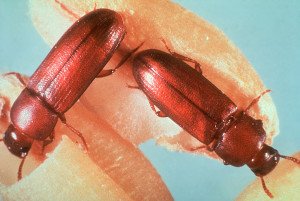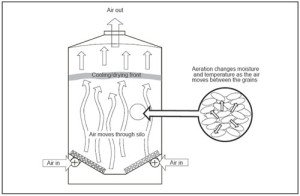Aeration cooling uses fans on grain storages to lower grain temperatures, which helps maintain grain quality and reduce storage pest problems.
When cooling grain using aeration, the aim is to reduce and keep grain temperatures below the following seasonal targets:
- Winter crops (stored November-March): below 23°C
- Summer crops (stored April-September): below 15°C
Most insect storage pests prefer temperatures from 25-35°C (peak breeding activity occurs at about 30°C, when lifecycles can be as short as 3-4 weeks).
Population increase of three of the main storage pest species (including rust red flour beetle) ceases below 20°C, and populations of all storage species stop increasing once the temperature falls below 15°C. Note that these temperatures do not kill the insects, and if grain temperatures rise, the populations will increase again.
Silos in cooler climates will achieve lower grain temperatures during summer. Storages on the Darling Downs should be able to achieve 18-23°C, while storages in Central Queensland may only reach 20-23°C.
Actions can growers take to achieve the best aeration cooling result include:
- appropriate equipment
- regular monitoring
- effective procedures.
Appropriate equipment
Ensure the fans and components are set up for maximum efficiency.
- Appropriate air flow rates
Aeration equipment should be appropriate for the size of storages and the grain types you’re aerating. Aim for fan airflow rates of 2-4 litres/sec/tonne (e.g. 100 t capacity silo full of grain should be receiving 200-400 litres of air per second). Note that the type of grain has a large influence on back pressure and thus fan airflow rates. - Fans running at the most optimal times
A good quality automatic aeration controller fitted to run fans at the most appropriate ambient conditions is vital. High air temperatures and/or humidity (especially foggy or rainy periods) should be avoided. Look for automatic controllers with good quality temperature and humidity sensors incorporated. Controlling fans manually is not recommended, as it is difficult to ensure that the fans are on at the optimal times, and all too easy to forget to switch them off. - Sufficient roof ventilation and internal ducting
Ensure appropriate ventilation is in place on the silo’s roof to prevent the fans from overworking (too much back-pressure reduces fan performance). Ducting size and design should also be carefully selected. Ensure ducting is easy to clean so it is not a haven for insect pests.
Regular monitoring
Monitor grain in storage for both insects and grain temperatures at least once a month. Take the opportunity to check grain quality at the same time.
- Monitoring temperatures
Temperatures can be easily and quickly monitored using a thermometer taped to a broom handle. Push the thermometer at least one metre into the grain and leave for at least three minutes before taking a reading. For more detailed long term grain temperature information in storages, storage cables are available. These are particularly useful when temporarily storing over-moisture grain. These cables can record grain temperatures and humidity. - Monitoring insects
Regularly monitoring for insects to allow a timely response is essential, as undetected populations can cause grain damage and lead to a bad reputation with buyers. Take samples from both the top and bottom of the silo for sieving. From the top, scoop at least 15 cm in; from the bottom, take half a bucket. Insect probe traps are also available commercially, and are very effective for early detection of storage pests.
Effective procedures
When harvesting crops in summer, grain temperatures are usually around 30°C (ideally suited to insect breeding), and if not aerated, will hold this warm temperature for months. Aeration fan should go through three stages to reduce grain temperature:
- Initial cooling (for the first 4-5 days): as soon as the grain in silo covers the aeration ducts, fans are run 24/7, pushing a cooling front from the bottom to the top of the silo
- For the next 5-7 days, the fans are operated only during the coolest 10-12 hours of the day, pushing a second cooling front through the grain by utilising lower night temperatures
- By about 2 weeks, the fans are then operated for about 100 hours per month, utilising the air with low temperature and humidity.
Good quality controllers are available that will automatically switch between these three stages. During the monthly storage checks, look at the fan run hour meters to ensure fans have run for approximately 100 hours (+/- 20%).
Benefits of effective aeration cooling
Successfully cooling and maintaining appropriate grain temperatures within silos results in:
- A good reputation
Reduced insect pest problems help built a reputation with buyers, as they will recognise you as consistently supplying a good quality insect-free product. - Potential for reduced fumigation
Pesticide-residue free grain is attractive in both the international and domestic marketplace. A combination of good storage hygiene (thoroughly cleaning empty silos) and effective aeration has the potential to control insect pests in two out of three years. Seasonal conditions can affect pest management, and even the best operators can have issues in some years with a combination of above average warm nights and high humidity. - Improved grain quality
Cool grain should result in: good germination for planting seed, maintaining colour in pulses, good oil quality in oilseeds, less likelihood of moulds developing, better flour quality etc.
More information
A wide range of stored grains information is available at storedgrain.com.au, including a booklet on Aerating stored grain – cooling or drying for quality control. A grain storage best practice summary called “Checklist” is also available. Insert “checklist” into the search box on this web site.
A range of grain storage information can also be found on the GRDC website.
A national hotline for stored grain enquiries is available at 1800 WEEVIL (1800 933 845), which will direct you to the stored grain extension officer in your region:
- North: Philip Burrill
- South: Peter Botta
- West: Ben White
Australia’s leading postharvest research team is based in Brisbane, and can be contacted regarding grains storage enquires, including pest resistance issues and testing:
- Pat Collins 07 3255 4467
- Manoj Nayak 07 3255 4439
Insect sampling probes, sieves and other grain quality test equipment is available from Graintech Scientific in Toowoomba.
Images sourced from the Queensland Department of Agriculture and Fisheries website.


